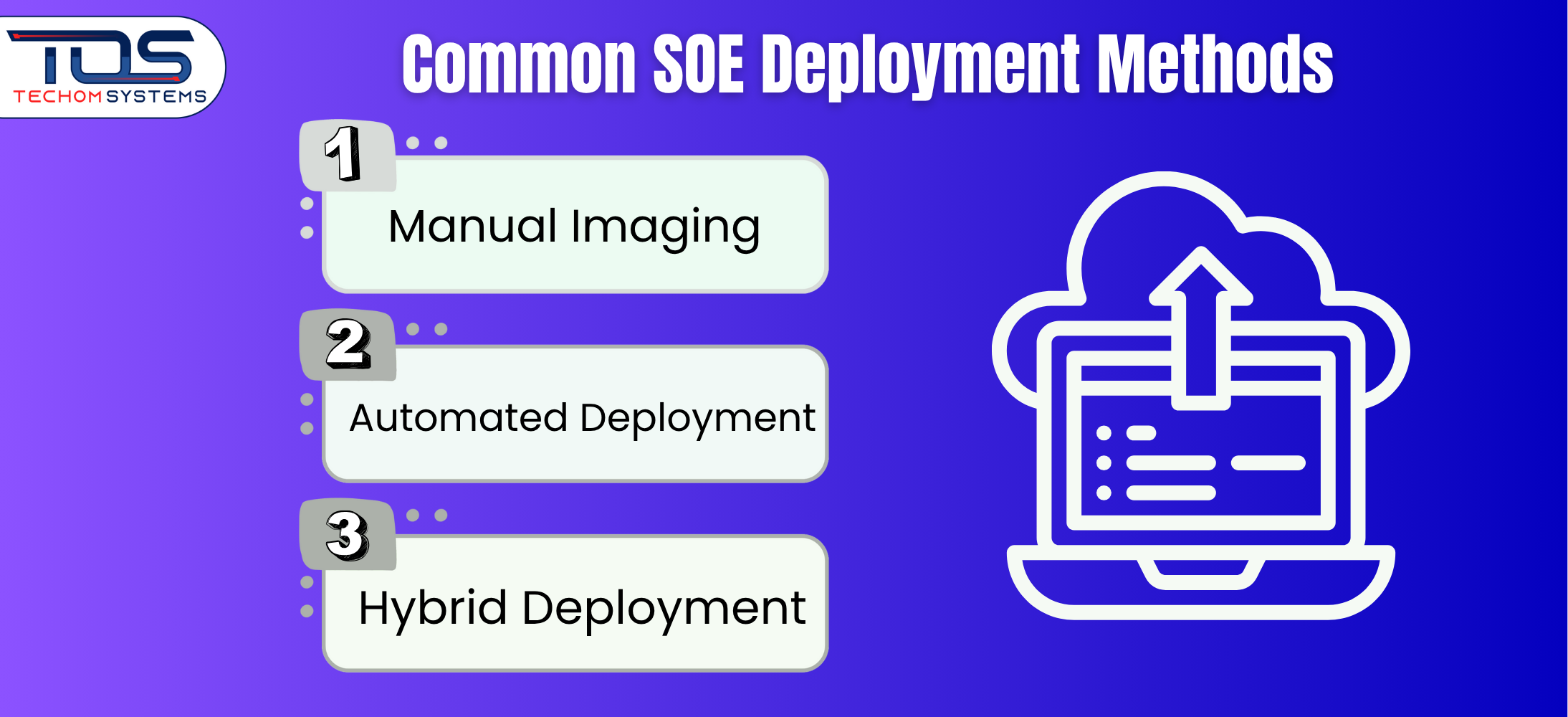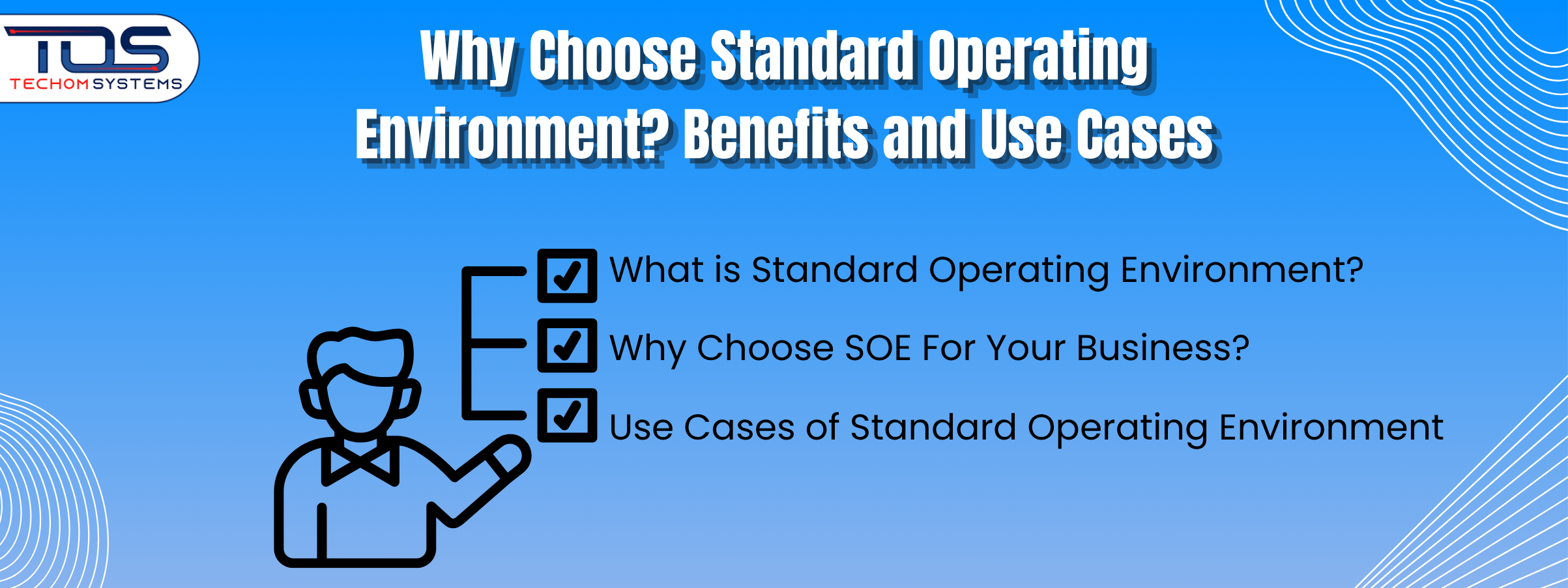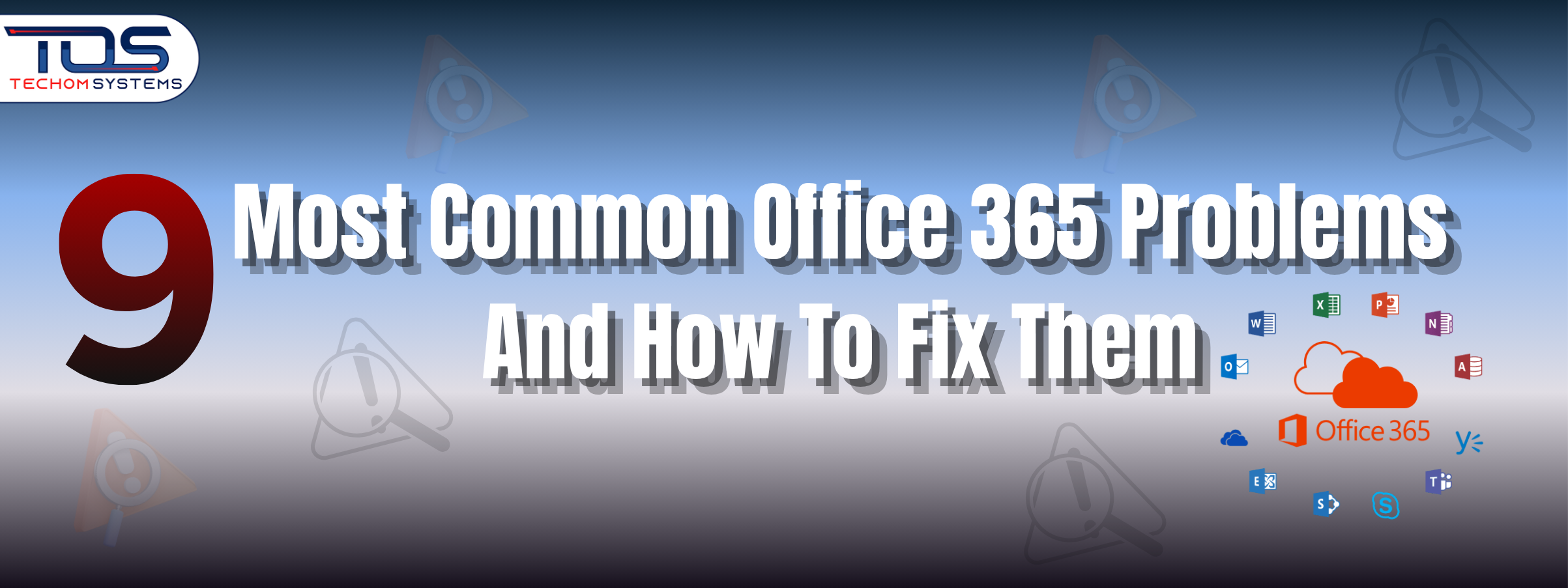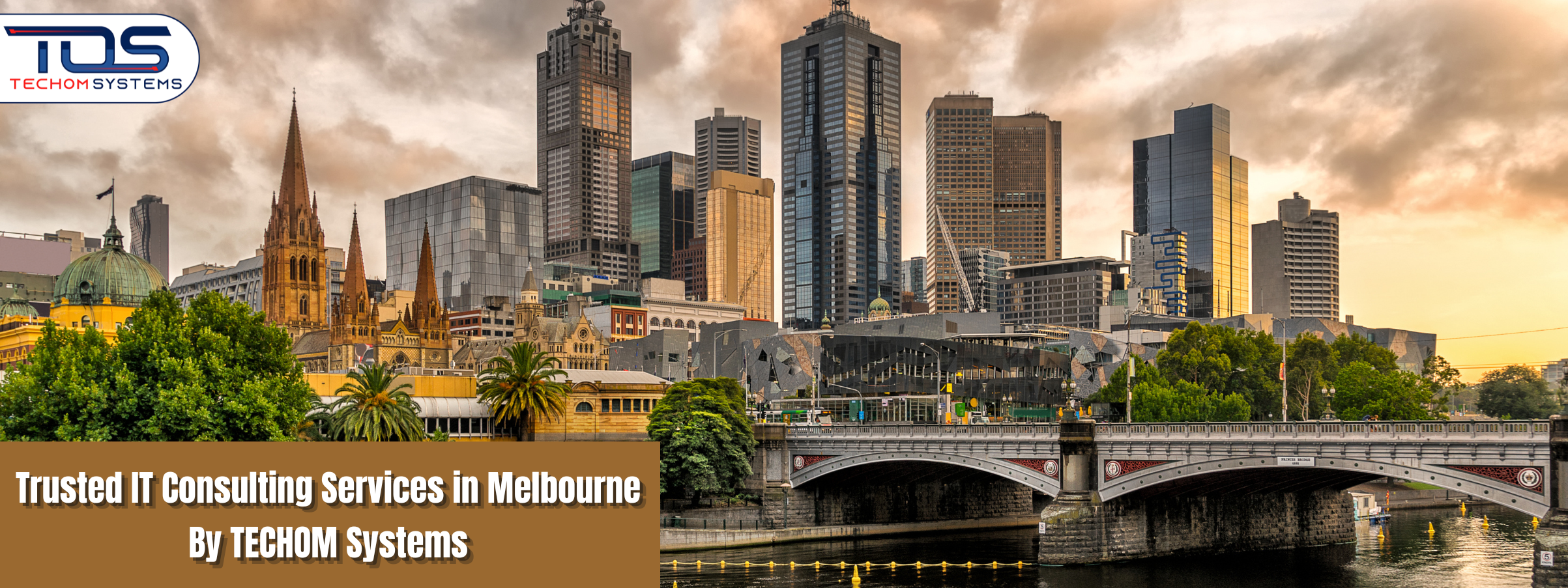Is your IT team struggling to manage different systems, software versions and device setups across the organization? Many businesses face these challenges every day, which leads to downtime, increased security risks and higher support costs.
If you are wondering why choose standard operating environment, the answer lies in creating a uniform and secure system setup that simplifies IT management. A Standard Operating Environment ensures that all devices follow the same configuration, making it easier to deploy updates, control security and reduce operational chaos.
In this blog, you will explore the key benefits of standard operating environment, common use cases and how to deploy an effective standard operating environment plan.
Need expert help with SOE deployment or consulting? Contact TECHOM Systems to streamline your IT operations today.
What is Standard Operating Environment?
Managing IT systems becomes difficult when every computer is set up differently. From software versions to security settings, small differences can cause big problems. This is where a Standard Operating Environment helps.
A Standard Operating Environment or SOE is a fixed setup of the operating system, software and settings used across all devices in a company. It gives IT teams one standard setup to install on every computer, laptop or server. Here is what it includes:
- Operating System like Windows or macOS
- Business software such as Microsoft 365 or antivirus tools
- Network and security settings to control access and protect data
- Device drivers for printers, monitors and other hardware
With a Standard Operating Environment in place, your IT team does not need to configure every machine from scratch. Instead, they apply the same image or template to all devices, which makes the process faster, more secure and easier to maintain.
SOE is not just for large businesses. Even small teams benefit from consistent setups, easier troubleshooting and fewer technical issues.
Why Choose SOE For Your Business?
When managing multiple devices across your organization, IT teams often face challenges like inconsistent setups, delayed updates and rising support costs. A Standard Operating Environment helps solve these issues by creating a unified system setup across all devices. Here are the main reasons why choose standard operating environment for your business:
- Improved Security
A consistent setup makes it easier for your IT team to install updates and apply security patches. This helps to close any security gaps and keeps your network safer from threats. - Faster Setup of New Devices
New laptops or desktops can be set up using pre approved templates. This saves time and ensures every device meets the same standards from day one. - Lower IT Support Costs
When all systems run the same software and settings, troubleshooting becomes simpler. Your support team can fix issues faster without checking for different configurations. - Better Compliance
A Standard Operating Environment helps your business follow internal IT policies and meet industry regulations. This is especially important in sectors with strict data protection rules. - Streamlined Operations
With the same tools and settings across departments, teams experience fewer tech related delays. It also improves collaboration and reduces confusion over software differences.
These benefits of Standard Operating Environment make it a smart choice for businesses planning to grow or manage remote teams effectively.
Common SOE Deployment Methods

Setting up a Standard Operating Environment can be done in different ways, depending on your organization’s size, infrastructure and needs. Choosing the right deployment method is important for long term success and smoother IT operations. Here are the most common SOE deployment methods:
- Manual Imaging
This method involves creating a disk image of your ideal setup and installing it manually on each device. It is a traditional approach that works for smaller teams or businesses without advanced IT tools. - Automated Deployment
In this approach, businesses use cloud based solutions like Microsoft Intune or Windows Autopilot to deploy the SOE remotely. It helps save time, ensures consistency and allows IT teams to configure devices from anywhere. - Hybrid Deployment
A mix of manual and automated methods, hybrid deployment is useful when businesses want the flexibility of cloud tools with the control of on premises setups. This approach offers scalability and works well for growing businesses.
At TECHOM Systems, we usually recommend automated deployment with Microsoft Intune. It makes managing devices easier and supports remote work environments more effectively.
Ready to streamline your IT operations with a Standard Operating Environment?
Contact TECHOM Systems today and let our experts guide you through a smooth and secure SOE deployment. We are here to simplify your tech, reduce your costs and support your growth.
Use Cases of Standard Operating Environment
A Standard Operating Environment is not just a technical solution. It plays a key role in everyday business scenarios where consistency, speed and control are important. From onboarding new hires to managing hundreds of devices, SOE helps IT teams stay ahead. Here are some common use cases where SOE proves highly valuable:
- Onboarding New Employees
When a new team member joins, SOE ensures their device is pre configured with the necessary tools and access. This saves time and allows them to start working on day one without delays. - Remote Workforce Management
For businesses with employees working from different locations, SOE helps in managing and securing all devices. It ensures each system stays updated and aligned with company policies. - IT Audits and Compliance
During internal reviews or external audits, SOE helps maintain a consistent environment. It provides better visibility and control over software versions, system settings and security protocols. - Large Scale Rollouts
When deploying many systems across departments or branches, SOE helps ensure uniform configurations. It reduces the chances of error and speeds up the entire rollout process.
If your business is growing or supporting remote operations, adopting a Standard Operating Environment can make your IT setup more efficient and reliable.
Difference Between SOE and MOE
When businesses start building an IT foundation, choosing between Standard Operating Environment (SOE) and Managed Operating Environment (MOE) becomes important. Both serve different needs, depending on how much control and automation a company requires.
SOE focuses on a consistent setup for all systems, while MOE goes a step further by adding user policies, automation and dynamic controls. The table below highlights the key differences between the two.
| Feature | SOE (Standard Operating Environment) | MOE (Managed Operating Environment) |
|---|---|---|
| Setup Type | Fixed and standardized | Dynamic and policy driven |
| User Policy Management | Not included | Fully integrated |
| Automation | Limited | High level of automation |
| Flexibility | Less flexible | Highly adaptable to business needs |
| Best For | Basic standardization needs | Advanced control and IT governance |
As companies grow or manage more complex environments, they often start with SOE and gradually move towards MOE. This shift helps them gain better control over their IT infrastructure while reducing manual effort.
Want to know which environment suits your business?
Get in touch with TECHOM Systems and let our experts guide you with a personalized solution that fits your current and future IT goals.
Steps To Build A Standard Operating Environment
Want to create a consistent, secure and easy to manage IT setup? A Standard Operating Environment (SOE) helps ensure all devices in your organization run on the same core setup. This improves performance, reduces errors and simplifies support for IT teams. Below are the key steps to build an SOE for your business:
1. Define Requirements
Start by identifying what your users need. This includes the operating system version, essential software, security settings and any configurations required for specific teams or departments.
2. Create a Template
Once you have the list of requirements, build a master image. This image should include the chosen OS, software packages and configurations. Make sure to test it properly on a few systems before rolling it out across the organization.
3. Choose Deployment Tools
When selecting the right tool for rollout, many organizations ask why choose Microsoft Intune deployment over traditional methods. Intune offers automated provisioning, policy enforcement and remote configuration, making it ideal for modern SOE strategies.
4. Monitor and Maintain
Even after setup, your SOE needs regular updates. This ensures your systems stay compliant with security policies and business requirements. Keep track of version updates, patch management and hardware changes.
5. Get Expert Help
Building an SOE is not always easy, especially when your business supports remote or hybrid teams. Partner with experts like TECHOM Systems for standard operating environment consulting, including customized planning, smooth deployment and long term support. Our team will help you design, implement and manage a solution that fits your unique needs.
Before building your setup, it is important to define a clear standard operating environment plan. This plan should include device requirements, approved software, security policies and the tools used for deployment. A well defined plan helps ensure that every system aligns with business goals and compliance standards.
Choose TECHOM Systems For Standard Operating Environment
Managing multiple devices across teams can quickly become a challenge if there is no consistent setup in place. A Standard Operating Environment (SOE) makes it easier to maintain security, reduce IT workload and improve productivity across your entire organization. Whether you are managing a remote workforce or preparing for a large scale rollout, TECHOM Systems can help you set up the right standard operating environment solution from day one, tailored to your business needs and infrastructure. Here is why TECHOM Systems is the right partner for your SOE needs:
1. Microsoft Intune Expertise
TECHOM Systems specializes in Microsoft Intune, a leading cloud based tool for modern device management. With Intune, we help you build and deploy your Standard Operating Environment remotely and securely. This ensures all endpoints stay compliant and up to date without manual effort.
2. Customized SOE Planning
No two businesses are alike. Our team takes the time to understand your current infrastructure, user needs and long term goals. Based on that, we design a Standard Operating Environment that fits your operations, whether you are using Windows 10, 11 or hybrid environments.
3. Remote Device Management
We help you manage your devices no matter where your teams are located. With secure access policies and centralized monitoring, your IT team gains full control over every system while reducing downtime and support requests.
4. Scalable Deployment
Whether you are onboard 10 employees or 1,000, our SOE rollout process ensures minimal disruption and maximum efficiency. From building the SOE image to automating deployment with Intune, we handle it all.
5. Ongoing Support and Updates
TECHOM Systems does not stop after deployment. We continue to monitor your SOE and provide regular updates, so your business stays protected and aligned with the latest compliance standards.
Still unsure why choose Standard Operating Environment? Visit our Microsoft Intune page or contact us to learn how we can simplify your Standard Operating Environment setup.
Also Read:
Frequently Asked Questions (FAQs)
#1 What Are The Benefits Of SOE?
SOE helps reduce IT costs, speeds up system deployment and improves security. It ensures all users follow the same setup, making updates and support easier to manage.
#2 What Is The Role Of The Standard Operating Environment?
A Standard Operating Environment ensures all devices run with the same settings, software and policies. It simplifies management, boosts productivity and strengthens security across the organization.
#3 What Is The Difference Between MOE And SOE?
SOE is a fixed setup with common tools, while MOE adds dynamic policies, automation and software control. MOE is more flexible, offering better management for complex environments.
#4 Why Do You Think An Operating System Is Essential?
An operating system manages hardware, runs software and allows user interaction. Without it, devices cannot function or perform tasks efficiently.
#5 Why Choose Standard Operating Environment?
If you are wondering why choose Standard Operating Environment, the answer is simple. It brings consistency, boosts security and makes IT management easier across your business. TECHOM Systems ensures a smooth and customized deployment.
Conclusion
In this blog, you have explored why choose standard operating environment for your business IT setup. From reducing deployment time to improving compliance and lowering support costs, SOE gives your team the structure it needs to work efficiently and securely. You also learned the difference between SOE and MOE and how to build a strong SOE with proper planning, tools and expert help.
If you are looking for consistency, faster onboarding and better IT control, this approach delivers long term value.
Still Wondering Why Choose Standard Operating Environment For Your Company?
Contact TECHOM Systems today and we will help you create the right solution for your growing business.

A results-driven content strategist and IT writer with over 7 years of experience simplifying complex tech concepts into clear, actionable insights. Specialising in cloud computing, cybersecurity, and enterprise IT trends, he crafts content that bridges the gap between technical depth and business value.





